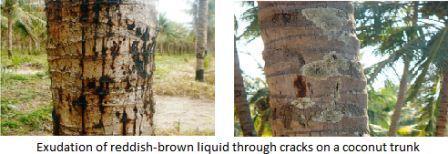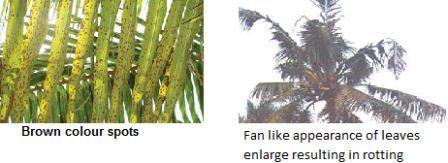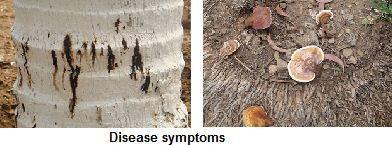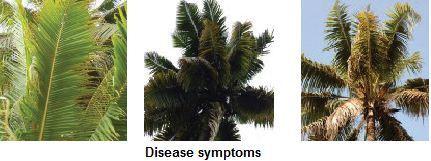Coconut: Diseases and Symptoms
Coconut: Diseases and Symptoms
Bud rot
Disease symptoms Palms of all age are liable to be attacked but normally young palms are more susceptible, particularly during monsoon when the temperature is low and humidity is very high. In seedlings, the spear leaf turns pale and comes off with a gentle pull.
Palms of all age are liable to be attacked but normally young palms are more susceptible, particularly during monsoon when the temperature is low and humidity is very high. In seedlings, the spear leaf turns pale and comes off with a gentle pull.- The earlier symptom is the yellowing of one or two younger leaves. Black spots appear on spindle leaves. Basal tissues of the leaf rot quickly and can be easily separated from the crown. Infection spreads to the older leaves, causing sunken leaf spots covering the entire leaf blade.
- Spot margins are irregular and water soaked, and when the leaves are unfolded the characteristic irregular spots are conspicuous on the blade.
- In the later stages the spindle withers and drops down.
- The tender leaf base and soft tissues of the crown rot into a slimy mass of decayed material emitting foul smell.
- Ultimately the entire crown falls down and the palm dies.
Stem bleeding
Damage symptoms Stem bleeding is characterized by the exudation of a dark reddish brown liquid from the longitudinal cracks in the bark and wounds on the stem trickling down for a distance of several inches to several feet.
Stem bleeding is characterized by the exudation of a dark reddish brown liquid from the longitudinal cracks in the bark and wounds on the stem trickling down for a distance of several inches to several feet.- The lesions spread upwards as the disease progresses.
- The liquid oozing out dries up and turns black. The tissues below the lesions become rotten and turn yellow first and later black.
- In advanced cases, the interior of affected trunks are hollow due to decay of interior tissues. As a result of extensive damage in the stem tissue, the outer whorl of the leaves turn yellow, dry and shed prematurely.
- The production of bunches is affected adversely. Nut fall is also noticed.
- The trunk gradually tapers at the apex and crown size becomes reduced in chronic cases.
Leaf rot
Disease symptoms The first symptom is the appearance of water-soaked brown lesions in the spear leaves of root-wilt affected palms.
The first symptom is the appearance of water-soaked brown lesions in the spear leaves of root-wilt affected palms.- Gradually these spots enlarge and coalesce resulting in extensive rotting.
- As the leaf unfurls the rotten portions of the lamina dry and get blown off in wind, giving a ‘fan’ shape to the leaves.
- Sometimes, the symptom becomes very acute and the spear fails to unfurl.
Tanjore wilt
Disease symptoms Initial symptoms of Thanjavur wilt (Ganoderma wilt) start with withering, yellowing and drooping of the outer whorl of leaves.
Initial symptoms of Thanjavur wilt (Ganoderma wilt) start with withering, yellowing and drooping of the outer whorl of leaves.- This is followed by exudation of reddish brown liquid through cracks at the base of the trunk and oozing spread upward. The tissues on the bleeding spots are soft to touch.
- Decaying of tissues at bleeding point and rotting of the basal portion of the stem.
- The bark turns brittle and often gets peeled off in flakes, leaving open cracks and crevices. The internal tissues are discoloured and disintegrated, emitting a bad smell.
- Bracket formation at the base of the trunk. Ganoderma appears at the base of the trunk. Ultimately the palm dies off.
Root (wilt)
Disease symptoms- The root (wilt) affected coconut are susceptible to diseases such as leaf rot and pests such as rhinoceros beetle and red palm weevil.
- Chance of confusing the pests and disease symptom with the root (wilt) disease

IPM for Coconut
To know the IPM practices for Coconut, click here.
Source: NIPHM and Directorate of Plant Protection, Quarantine & Storage
Last Modified : 3/1/2020
© C–DAC.All content appearing on the vikaspedia portal is through collaborative effort of vikaspedia and its partners.We encourage you to use and share the content in a respectful and fair manner. Please leave all source links intact and adhere to applicable copyright and intellectual property guidelines and laws.
RELATED ITEMS
Coconut cultivation practices
This topic provides information about package of p...
Arecanut Diseases
This topic covers information about Arecanut Dise...
Coconut: Natural Enemies
Natural enemies of Coconut insect pests are covere...
Coconut: Insect, Mite and Nematode Pests
This topic covers the information related to Insec...
